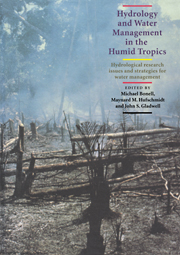 Hydrology and Water Management in the Humid Tropics
Hydrology and Water Management in the Humid Tropics Book contents
- Frontmatter
- Contents
- List of Authors
- Foreword by Federico Mayor, Director-General, UNESCO
- Preface
- Cartographic Credit
- Acknowledgements
- SECTION I INTRODUCTION
- SECTION II HUMID TROPICS SETTING
- SECTION III REGIONAL HYDROLOGY
- SECTION IV PHYSICAL PROCESSES
- SECTION V PHYSICAL PROCESSES – HUMAN USES: THE INTERFACE
- SECTION VI MANAGEMENT ISSUES
- 22 Water Resource Management
- 23 Water Management Issues: Population, Agriculture and Forests – A Focus on Watershed Management
- 24 Urban Water Resources in the Humid Tropics: An Overview of the ASEAN Region
- 25 Urban Water Problems in the Humid Tropics
- 26 Rethinking Urban Water Supply and Sanitation Strategy in Developing Countries in the Humid Tropics: Lessons from the International Water Decade
- 27 Water Resource Management Issues in the Humid Tropics
- SECTION VII APPENDICES
- Place index
24 - Urban Water Resources in the Humid Tropics: An Overview of the ASEAN Region
Published online by Cambridge University Press: 23 December 2009
- Frontmatter
- Contents
- List of Authors
- Foreword by Federico Mayor, Director-General, UNESCO
- Preface
- Cartographic Credit
- Acknowledgements
- SECTION I INTRODUCTION
- SECTION II HUMID TROPICS SETTING
- SECTION III REGIONAL HYDROLOGY
- SECTION IV PHYSICAL PROCESSES
- SECTION V PHYSICAL PROCESSES – HUMAN USES: THE INTERFACE
- SECTION VI MANAGEMENT ISSUES
- 22 Water Resource Management
- 23 Water Management Issues: Population, Agriculture and Forests – A Focus on Watershed Management
- 24 Urban Water Resources in the Humid Tropics: An Overview of the ASEAN Region
- 25 Urban Water Problems in the Humid Tropics
- 26 Rethinking Urban Water Supply and Sanitation Strategy in Developing Countries in the Humid Tropics: Lessons from the International Water Decade
- 27 Water Resource Management Issues in the Humid Tropics
- SECTION VII APPENDICES
- Place index
Summary
ABSTRACT
South East Asia is one of the most populated regions within the humid tropics and is fast becoming an enclave of industrial development. Geographically, it is endowed with a good source of water, due to its copious rainfall. However water resource problems often arise because of variations in distribution, timing and the small sizes of the catchments. The last few decades also witnessed the rapid deterioration of the available water due to anthropogenic activities causing pollution, reducing further the available water. Demands, on the other hand, have increased with rising urbanization and industrial development. In many countries, balancing a good water supply and demands is a major issue requiring more than environmental controls. It may require very stringent legislation to control the water sources. It is the aim of this chapter to examine some of those inherent problems so that scientists, mitigation planners and engineers can address them in their detailed resource planning.
INTRODUCTION
The humid tropics is a geographical region recognized by its climatic similarities. Quantitative definitions have been given by Chang & Lau (1983) as a region having a minimum of 4.5 wet months per year and an average minimum temperature of 18°C (See Appendix A, this volume). Vitousek & Sanford (1986) have defined it as an area lying 23° N and 23° S and receiving at least 1,600mm of annual rainfall. Within this broad region astride the equator lies an assortment of countries which could be categorized further, based either on economic status, geographical size or political alignment. The first is used by macro-economists to show the levels of development within and between regions, and will also be used in this chapter.
- Type
- Chapter
- Information
- Hydrology and Water Management in the Humid TropicsHydrological Research Issues and Strategies for Water Management, pp. 526 - 534Publisher: Cambridge University PressPrint publication year: 1993
